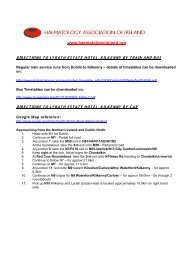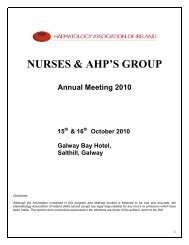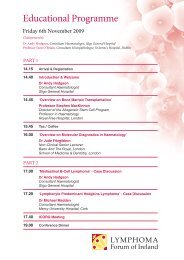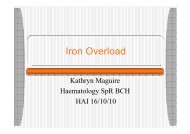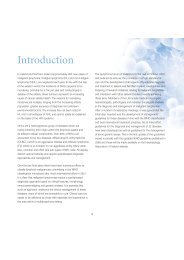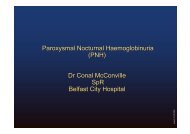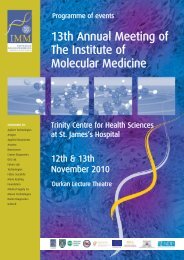Guidelines on Diagnosis and Treatment of Malignant Lymphomas
Guidelines on Diagnosis and Treatment of Malignant Lymphomas
Guidelines on Diagnosis and Treatment of Malignant Lymphomas
You also want an ePaper? Increase the reach of your titles
YUMPU automatically turns print PDFs into web optimized ePapers that Google loves.
Mycosis Fungoides <strong>and</strong><br />
Sézary Syndrome<br />
Definiti<strong>on</strong> <strong>and</strong> Incidence<br />
Mycosis Fungoides is the comm<strong>on</strong>est primary cutaneous<br />
lymphoma, accounting for almost 50% <strong>of</strong> all primary cutaneous<br />
lymphomas. Mycosis fungoides is a mature T-cell lymphoma<br />
presenting in skin with patches or plaques <strong>and</strong> showing<br />
epidermotropism by T lymphocytes.<br />
Sézary syndrome (SS) is a related but generalised T-cell<br />
leukaemia presenting with erythroderma, generalized<br />
lymphadenopathy <strong>and</strong> circulating cl<strong>on</strong>ally related neoplastic<br />
cerebriform T-lymphocytes in the peripheral blood, <strong>and</strong> behaves<br />
more aggressively. In additi<strong>on</strong>, <strong>on</strong>e or more <strong>of</strong> the following<br />
criteria are required: an absolute Sézary cell count <strong>of</strong> at least<br />
1000 cells per mm3, an exp<strong>and</strong>ed CD4 T-cell populati<strong>on</strong> resulting<br />
in a CD4/CD8 ratio <strong>of</strong> more than 10 <strong>and</strong>/or loss <strong>of</strong> <strong>on</strong>e or more<br />
T-cell antigens. Sezary syndrome comprises less than 5% <strong>of</strong><br />
primary cutaneous T cell lymphomas.<br />
ICD-O Code 9700/3 (Mycosis fungoides)<br />
9701/3 (Sézary syndrome)<br />
Clinical Presentati<strong>on</strong><br />
Mycosis Fungoides has a l<strong>on</strong>g natural history, <strong>and</strong> patients may<br />
have n<strong>on</strong>-specific scaly lesi<strong>on</strong>s for years before diagnostic<br />
histology develops. Eventually, progressi<strong>on</strong> occurs to more<br />
generalised plaques <strong>and</strong> eventually to tumours in some patients.<br />
Some patients develop generalised erythroderma. Extracutaneous<br />
disseminati<strong>on</strong> is a late event <strong>and</strong> occurs mostly in<br />
patients with extensive or advanced cutaneous disease with<br />
spread to lymph nodes, liver, spleen, lungs <strong>and</strong> blood. B<strong>on</strong>e<br />
marrow involvement is rare. Folliculotropic MF preferentially<br />
affects the head <strong>and</strong> neck <strong>and</strong> <strong>of</strong>ten presents with grouped<br />
follicular papules associated with alopecia. Sezary syndrome is a<br />
generalized disease with widespread visceral organs involvement<br />
but frequently a clear b<strong>on</strong>e marrow.<br />
Pathology <strong>and</strong> Genetics<br />
Biopsy <strong>of</strong> the skin lesi<strong>on</strong>s shows epidermal infiltrati<strong>on</strong> <strong>of</strong><br />
small- to medium-sized cells <strong>and</strong> irregular cerebriform nuclei<br />
may not be seen in early lesi<strong>on</strong>s. Pautrier microabscesses<br />
(aggregates <strong>of</strong> cells with cerebriform nuclei, generally in<br />
n<strong>on</strong>sp<strong>on</strong>giotic epidermis) are characteristic but not comm<strong>on</strong> in<br />
early lesi<strong>on</strong>s. Epidermal involvement with epidermotropism by<br />
single lymphocytes is more comm<strong>on</strong> <strong>and</strong> lining up <strong>of</strong> haloed<br />
lymphocytes al<strong>on</strong>g the dermo-epidermal juncti<strong>on</strong> can be seen.<br />
Dermal infiltrates may be patchy, b<strong>and</strong>-like or diffuse, depending<br />
<strong>on</strong> disease stage. There is <strong>of</strong>ten an associated inflammatory<br />
infiltrate <strong>of</strong> small lymphocytes <strong>and</strong> eosinophils. With progressi<strong>on</strong>,<br />
epidermotropism can be lost. Histologic transformati<strong>on</strong> is defined<br />
by the presence <strong>of</strong> >25% large lymphoid cells in the dermal<br />
infiltrate <strong>and</strong> is seen mainly in tumour stage disease. These cells<br />
may be CD30 positive or negative. Enlarged lymph nodes when<br />
present frequently show dermatopathic changes with<br />
paracortical expansi<strong>on</strong> due to the presence <strong>of</strong> large numbers<br />
<strong>of</strong> Langerhans cells with abundant pale cytoplasm.<br />
In Sezary Syndrome, T-cells with markedly c<strong>on</strong>voluted (cerebriform)<br />
nuclei are present in the peripheral blood (Sezary cells).<br />
Phenotype<br />
Most are CD2+, CD3+, CD4+, CD5+, Alpha-beta TCR+, <strong>and</strong><br />
CD8-. Occasi<strong>on</strong>ally they may be CD8+ or gamma-delta TCR+.<br />
Some cases may express activati<strong>on</strong>-associated antigens including<br />
HLADR, CD25, CD30, CD38 <strong>and</strong> proliferati<strong>on</strong> associated<br />
antigens such as CD71 <strong>and</strong> Ki67, especially in advanced stages.<br />
50




